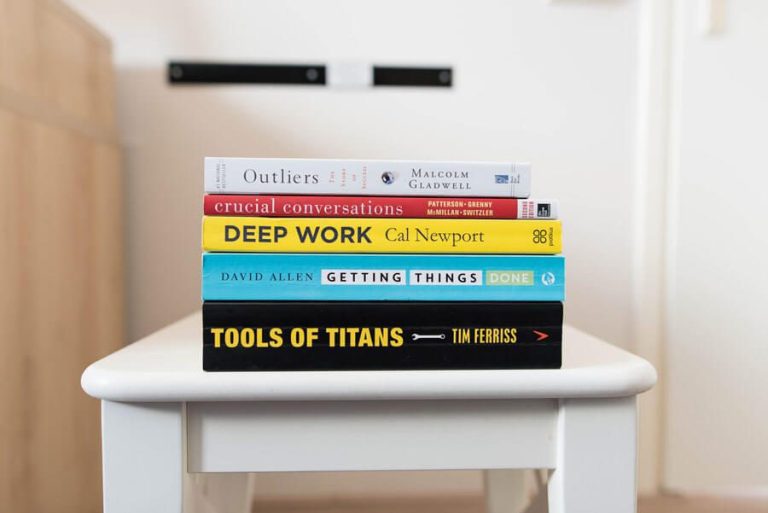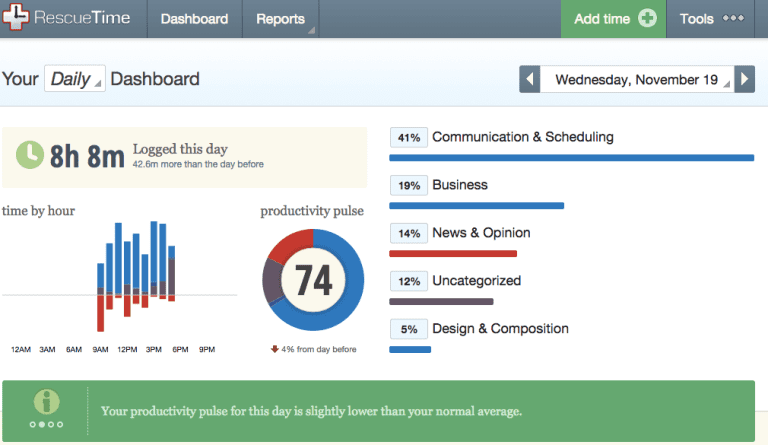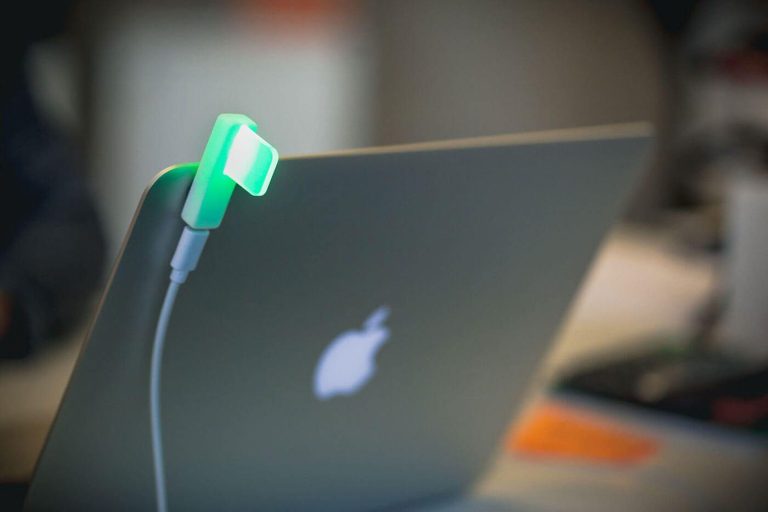15 Simple and Super Productive Steps How To Master
'Deep Work' for Team Leaders and Executives
Here’s a question for you. During your typical workday, how much of it is spent reading and answering emails, calling and rushing to meetings? And how much of your workday is actually spent in deep focus making a meaningful contribution to your team, or your career as a whole?
Regardless of whether people are working from home or the office, there still remains such productivity issues as trouble focusing, too many distractions, lack of planning, and fixation on the so-called ‘busy work’ as opposed to ‘deep work’.
So if you battle constant interruptions throughout the day, spend too much time in reactive mode responding to emails and messages, and have to juggle many different projects and responsibilities, this article is for you.
Why Deep Work?
In his bestseller Deep Work, Cal Newport explains how the established corporate culture and the practice of busyness directly damage productivity and cause enormous losses of money company-wise. Newport also explores the importance of focus for the benefit of many professions of today and future.
He believes that “We could be missing out on our lifetime’s great thinkers, innovators, and artists, because of workplace distractions.” Simply because we are working against our brains’ true potential to help us become masters of our craft.
Deep Work for project managers, team leaders and executives
Achieving deep work is a more complicated challenge for executives and team leaders. As reported by Harvard Business School, upper and middle management spend on average 13 hours per week on activities that were not planned in advance.
Yet we know that deep work is possible for CEO’s and team leaders. Implementing deep work into your workday generally means you’ll have to limit distractions as much as possible, and form a habit for a couple of hours’ deep concentration.
In this guide, you’ll find a 15-step action plan giving you tips and tricks, strategies and tools how team leaders can practice deep work and encourage the same in their work environment.
What is Deep Work?

Source: Unsplash
By Newport’s definition, deep work is defined as:
“Professional activity performed in a state of distraction-free concentration that push your cognitive capabilities to their limit. These efforts create new value, improve your skill, and are hard to replicate.”
However, the work that most likely naturally fills your day is a different type. If you aren’t intentional about how you spend your time, your work hours slip away towards activities that Newport refers to as shallow work:
“Non-cognitively demanding, logistical-style tasks, often performed while distracted. These efforts tend to not create new value in the world and are easy to replicate.”
Newton especially stresses how rare deep work is in today’s society, and “at exactly the same time it is becoming increasingly valuable in our economy”. Meaning that only the professionals that know how to practice deep work are able to achieve excellence.
Fragmented attention towards minor and trivial tasks like emails, customer support, and administrative work, mixed with impulsive procrastination, therefore, seriously get in the way of maintaining of a truly productive environment.
However, that doesn’t mean we should completely abandon these seemingly petty tasks, as long as they are still the means to achieve something. It simply suggests that we need to reform how we focus on the execution of both, smaller and larger, tasks.
So essentially the formula for achieving deep work is essentially: getting rid of distractions + enhancing your focus. Let’s move on to our action plan of 15 tips and tricks, as well as tools and strategies that will help you achieve deep work.
15-Step Action Plan: Tips & Tricks, Tools & Strategies For Mastering Deep Work

Source: Freepik
The following list gives you practical methods that you can apply right away to master deep work. This list will also be helpful when giving tips to your coworkers how they can, too, achieve that flow state and get things done with ease.
Related: The Ultimate Productivity Formula for Making More Money: The Secret Revealed
1. Determine your most and least productive times of the day
No person is wired that way so to be 100% productive all the way through the classic 9-to-5 working hours. To practice deep work in your daily routine you need to know your flow and assess which times of the day are the most and least productive for you.
The important aspect here is not deciding whether you are a morning person or a night person, but rather to realize when you are naturally feeling the most productive and then making the most of it.
For example, if you’re fully alert and focused by 7:00 am, then that’s when you should start working on your first priority. If you’re more productive from 1:00 pm to 4:00 pm, then block out that in your calendar for your most important work.
But if your day is packed with meetings and involves dealing with many minor tasks and fixing urgent issues, how can you really know your productive time?

Source: RescueTime
Pro tip:
We love using RescueTime – it’s a super helpful software that automatically logs where your time is spent when you’re using your computer, phone, or tablet. Just having it run in the background on all your devices for a week will paint a sufficient enough picture how you use your working hours. Label which activities count as productive or unproductive for you, and see which times of the day you naturally tend to tackle the important tasks.
2. Create theme days
As a team leader, project manager, or CEO, you probably have a lot on your plate. However, rapid switching between tasks is very detrimental to your productivity. With most workers these days trying to juggle 5 tasks at the same time, we’re losing up to 80% of our productive time each day because of it.
One way of tackling this is grouping up similar tasks and dealing with them on particular days of the week. So instead of attempting to do 10 different things in one day, organize all your meetings on Monday, dedicate Tuesdays for writing reports, or make Wednesdays the days when you check in on the current projects and deal with issues. The other days of the week can be assigned as creative time or actual work time where you focus on improving your product or doing anything else that makes a meaningful contribution to your team and your company.
If you have standing clients, you might as well assign each client a specific day or window that you work solely on their projects. This works well if you have a set amount of work each week that doesn’t require daily check-ins.
This method helps to create a consistent flow, prevents from multitasking, and ensures you are able to give all your rapt attention to each and every client, project, and task.
3. Use time blocking to batch tasks

Source: Freepik
If your work varies each week or there aren’t that many tasks of the same sort to fill up a day, simply segment your work days into time blocks.
Time blocking forces you to fill up free time with pre-commitments and a plan of action. Also, it reduces the number of choices you’d have to make in any given moment – boosting your willpower for peak productivity.
Here are 3 simple and easy steps to apply the time blocking method:
Step 1: Divide a piece of ruled paper into two columns. On the left column allocate every two lines to each hour or 25-minute block of the day (or 5 minutes, whichever you prefer).
Step 2: Estimate the amount of time each task is going to take to complete, then write these tasks on the left column with their respective time blocks.
Step 3: Add buffer times or extra room around each time block to allow for adjustments or unexpected activities.
It’s also important that as much as possible in Step 2 above, you avoid underestimating how long the completion of a task would require. When we’re too optimistic about how long a given task is going to take, we fail to completely follow through on what we set out to do. This bias (also known as the ‘planning fallacy’) can be avoided by simply keeping a timed record of how long your daily activities take to complete. We recommend using apps like Toggl for time tracking or evaluating the data recorded by RescueTime.
If you have bigger tasks to complete that may require a long time to complete, simply break these down into smaller subtasks and slot them into your time blocks. Time blocking for ‘reactive’ work, like responding to emails, Slack messages, and fixing issues, could also help you to avoid overwhelm, reduce stress and stay focused throughout the day.
Ideally, to achieve effective time blocking, you should spend up to 10 minutes the previous evening planning out your time blocks for the next day.
4. Enhance your focus using the Pomodoro technique

To maintain your focus and work even more effectively, take the time block allocated to a task and divide it further into manageable chunks. This technique is also known as Pomodoro, and is incredibly helpful for enhancing your focus and allowing your mind to recharge. For example, divide your time into blocks of 25-minute deep work and 5-minute rest, or 45-minute work and 10-minute rest – whatever suits you best.
However, for all the minor tasks you have to do, group them up in one Pomodoro block, and have a dedicated time in your calendar for that. If you do all your emails and administrative work twice a day, at, say, 9:30 and 16:30 sharp, there’s no point in checking your inbox every now and then throughout the day. For a more detailed info on using Pomodoro for different tasks, check out this article: The Ultimate Guide How To Use Pomodoro Technique When Working On Different Tasks.
Pro tip:
Luxafor software lets you implement the Pomodoro technique even better with automatically scheduled signals that notify you on the intervals of work and rest – no annoying sounds, just a pretty bright LED in any color you’d like.
5. Get rid of distractions
Now that you’ve scheduled your deep work in time slots, first thing’s first: put your phone away. Seriously, works like a charm. One study found that simply having your phone nearby is enough to hurt your ability to concentrate (even if the phone is off). Eliminate the chances of being pulled into the black mirror by simply not having it around you.
Secondly, block unnecessary websites, even if you don’t mean to browse any news or social media sites today. StayFocusd lets you enter a daily limit to visiting blocked sites. Its NUKE ‘EM option blocks all sites, except those you’ve allowed for the number of hours you indicate for a truly no-bullshit no-distraction work.
6. Set boundaries and communicate you're in 'deep work' mode
Much like you put your phone on “do not disturb”, you must find a way how you can isolate from the surrounding busyness so to help yourself go into the state of deep work. As much as open offices are thought to spark creative collaboration, they provide plenty of room for distractions. Discussions on Slack are, too, a great source of constant interruptions. The same goes if you’re working from home – if you don’t set your boundaries, your relatives may simply assume you’re always available for a little chat.
It really boils down to this: if you don’t properly communicate to others that you’re busy, you will get interrupted. Here’s what to do to properly communicate you’re about to dive into the deep work state.
First of all, switch your status to “Away” or “Busy” in Slack or any other team communication platform you and your colleagues use.

Secondly, if you’re dealing with real-life interruptions by colleagues and people at home, invest in a LED busylight, like Luxafor Flag, that lets everyone know whether you’re doing deep work, up for collaboration, or on a break.

Alternatively, if you have your own office, and people keep popping in despite the post-its on your door, a smart LED solution can be the ultimate fix. Luxafor Bluetooth, a wireless & software-controlled LED availability indicator, displays your personal availability for others, and notifies you of only the most important stuff.
Pro tip:
Automate it all through Zapier – connect your Luxafor Flag / Luxafor Bluetooth with Slack, and once you turn the red light on, your status automatically switches to “away”. Plus, you can always automatically schedule your focus sessions in Luxafor software!
7. Dedicate longer deep work sessions for top priorities and difficult tasks
Our brains are naturally drawn to instant gratification, that’s why it’s more satisfying to browse social media rather than embark on a difficult task that requires intense focus. That explains why we’re also more inclined to reply to emails now and then, because it produces immediate effect, plus, counts as “work”.
If you want to maximize your potential, the times when you feel truly productive should be used for the most important and difficult tasks. It helps to ask yourself “Is what I’m doing moving the needle or is it keeping me busy?” When you look back a year later, or even a month later, will this work you’re doing have made an impact? If not, is there something more important to accomplish that will provide long-term leverage for your business?
Related: The Eisenhower Matrix: Time and Task Management Made Simple
Whenever you have a particularly hard task on your to-do, make the effort of prioritizing it. It will be worth it! Books like Deep Work, Hyperfocus and Eat That Frog! remind how important it is to simply start, even if it’s a frog you have to eat every day for a living (eat it first thing in the morning, and no more frog eating for that day!). Once you begin, it’s much easier to get into your flow. Besides, deep work gives you a wonderful sense of accomplishment, especially if you’ve just accomplished the hardest task at hand.
8. Set aside time for planned breaks

Source: Freepik
Somehow we tend to praise people for working overtime, taking on extra projects and barely stepping away from their desk, even though it’s been proven to damage productivity, mental well-being, and can pretty soon lead to a burnout. That’s not a recipe for deep work, that’s a recipe for a disaster!
The Pomodoro methodology suggests taking a longer break of 15 to 20 minutes after about every 4 Pomodoros (given their length is 25 minutes). However, if you don’t divide your workday in Pomodoros only, then simply schedule your breaks when it’s convenient. The US Federal Law suggests taking two 15 minute breaks 2 hours apart, and a 30 minute lunch break at a convenient time during the day.
If you frequently skip the suggested breaks, or even remain glued to the chair during your lunch break, schedule them into your calendar, and really make use of the time off.
Pro tip:
Luxafor software has integrations with Google Calendar, and more than 2,000 other popular apps and services, so you can set up your Luxafor Flag or Luxafor Bluetooth to blink you a certain signal whenever you should take a break.
9. Clear the clutter in your physical space

Source: Unsplash
Having a tidy physical space is an obvious, yet an underrated tip. A clean and clear workspace can make you think more clearly and focus better on your deep work, because there is simply less visual clutter to distract your eye.
The same goes for digital clutter on your desktop and in your Downloads folder. Whenever there’s a timed break, tidy your hard drive, and organize it in a simple but easy-to-use system, so that you never waste another 15 minutes searching for important documents. Or you can do it as a routine first thing in the morning to start your day off right.
10. Incorporate mindfulness and meditation techniques
Perhaps even more important is to take care of clearing your mind. Many successful entrepreneurs believe that it is meditation allows them to perform so well in their daily tasks.
Dedicate one of your breaks to practice meditation or a simple mindfulness exercise. It can only take five or 10 minutes, and that will be enough to help you become more aware of what’s going on in your body and mind, declutter your mental space, and spark a new current of deep focus.
Related: The Surprising Benefits Of Doing These 7 Mindfulness Exercises At The Office
11. Brainstorm whenever you can
If you’re wondering how you can max out the time you have on your hands, then a good idea is to use trapped time, like when you’re commuting, waiting for an appointment, exercising, or cleaning, for brainstorming on concepts or figuring out solutions. Instead of zoning out to music or flicking through social sites, you can train your mind to use these bits of time you have to work on the knotty sections of your deep work.
Not all of us work on solving computer algorithm problems like Newport, but this technique can translate across most disciplines. Copywriters can plan out the structure of a blog, teachers can conceptualize a lesson plan, and executives can map out the key things to include in the upcoming presentation.
On the other hand, if your day to day challenges often make you feel anxious, the time when you’re commuting, cleaning, or doing any other repetitive task can be very beneficial for practicing simple meditation.
12. Reinforce the positive feeling of getting work done

Source: Freepik
As Cal Newport pointed out, there’s something so genuinely satisfying being in the zone, deeply focused on the task at hand, so much that you lose any awareness of the time passed. This happy and productive feeling is also known as flow state, and it is synonymous with deep work.
Whenever it happens, try to catch that feeling and embrace it fully. The next time you struggle starting your day on full focus mode, remind yourself how good it feels to be in the zone. How great you’ll feel afterward, having accomplished what you had on your to-do list. The positive reinforcement will motivate you to get there more often.
13. Have a personal ritual to unlock your flow state
Everyone has their day to day routines, but not everyone is aware that they also have their rituals – personal, meaningful practices they do. While a routine may be something that simply needs to be done – such as taking a shower or driving to work – rituals have a specific intention, and a real sense of purpose that allows you to gain more out of the activity. For example, a ritual can be naming three things you are grateful for every time you commute to work.
Similarly, you can make your coffee first thing in the morning and chug it down without making a big deal of it. Or: before you undertake the most difficult task of the day, you can make yourself a nice cup of tea and pause for a quick mindfulness practice with the intention of boosting your focus for the next couple of hours. Simply put, a well-intentioned ritual can rewire your brain for success.
It might be beneficial to make a checklist of what helps you achieve that flow state: e.g., 1. Make tea, 2. Light a candle, 3. Switch status to busy via Luxafor Flag and Slack, 4. Activate BlockSite plugin, 5. Set Pomodoro for 45 minutes and 10 minute break, 6. Put on a Spotify playlist etc.
Whenever you’re about to do an important task that requires your utmost attention, have your list with you and ensure you follow your own personal algorithm for achieving that rewarding state of deep work.
14. Have an official end to the workday
Newport also emphasizes how healthy it is for the mind to have an official end to the workday. Sure, many hard-working team leaders tend to work overtime, but having a healthy respect towards the working hours is beneficial for your own sake. A good take-away lesson is this: when you know it’s time to quit, don’t fight it. Yes, there are probably a million things you could do, but is it worth it to power through them if you have barely any power left?
Learn to put an end to the workday without any guilt, but with the confidence of what you have achieved. Here also a small ritual could help celebrate this end – cross out the items of your to-do list, crumple it up and slam-dunk it into the bin if you wish, write down your gratitudes of the day, or simply set a main goal for tomorrow.
15. Establish a rejuvenating after-work routine
Your after-work routine matters as well, because the way you spend your free time has a great impact on how you feel at work. Surely, after a hardcore day at the office, your brain seeks the easiest possible way to rewind, which rarely turns out to be a wholesome and healthy pastime.
Yet, you shouldn’t beat yourself up for wanting to watch your favorite show or have a beer with your friends, as long as it’s in moderation. However, if you need some new ideas for some healthy habits to add to your after-work routine, check out 5 recommendations in our blog!
Related: 5 Habits To Add To Your After-Work Routine To Boost Productivity
Some final words
There’s no single magic formula, method, or tool that will help you get to deep work in an instant (and if there was, you bet, we would give it to you!). The best thing we can do is give you these actionable tips and tricks that help you get there more effectively, in your own time.
Deep work, ultimately, is all about rewiring your brain, and it’s something we need to train our brains to do more often, if we want to succeed. We really hope you found this action plan useful, and you’ll start implementing some of these methods today!



